

The Aymestrey burial was a beaker cist at Aymestrey, Herefordshire, England. The remains and objects are now in a recreated cist, at Leominster Museum.


The Aymestrey burial was a beaker cist at Aymestrey, Herefordshire, England. The remains and objects are now in a recreated cist, at Leominster Museum.
While working a gravel quarry at Aymestrey, in June 1987, employees of ARC unearthed a hole with a stone lining, and human remains visible within. They called in archaeologists from Hereford and Worcester County Council, who carried out an excavation and discovered a stone-lined burial pit containing the body of a child, lying on its left-hand side in a foetal position. Alongside the body were an earthenware bell beaker and a flint knife. [1] [2] The burial was dated to the Early Bronze Age. [1]
The site lies between the Iron Age hill forts at Pyon Wood and Croft Ambrey, and alongside a tributary of the River Lugg. A similar beaker burial site was also discovered in 1987 in Achavanich, Caithness, Scotland. [3]
The burial has been recreated as a display at Leominster Museum (pictured).
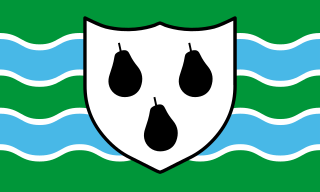
Worcestershire is a county in the West Midlands of England.

Hereford is a cathedral city, civil parish and the county town of Herefordshire, England. It lies on the River Wye, approximately 16 miles (26 km) east of the border with Wales, 24 miles (39 km) southwest of Worcester, and 23 miles (37 km) northwest of Gloucester. With a population of 60,800, it is by far the largest settlement in Herefordshire.
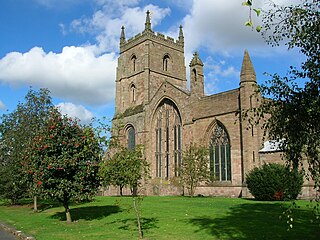
Leominster is a market town in Herefordshire, England, at the confluence of the River Lugg and its tributary the River Kenwater. The town is 12 miles (19 km) north of Hereford and 7 miles south of Ludlow in Shropshire. With a population of 11,700, Leominster is the largest of the five towns in the county.
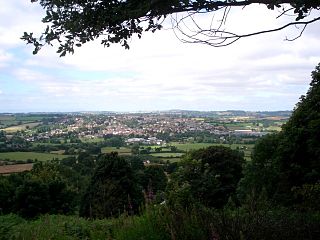
Bromyard is a town in the Bromyard and Winslow civil parish in the county of Herefordshire, England. It is situated in the valley of the River Frome. The 2011 census gives a population of approximately 4,500. It lies near to the county border with Worcestershire on the A44 between Leominster and Worcester. Bromyard has a number of traditional half-timbered buildings, including some of the pubs, and the parish church dates back to Norman times. For centuries, there was a thriving livestock market. The town is twinned with Athis-de-l'Orne, Normandy.

Herefordshire is a county in the West Midlands of England, governed by Herefordshire Council. It is bordered by Shropshire to the north, Worcestershire to the east, Gloucestershire to the south-east, and the Welsh counties of Monmouthshire and Powys to the west.

Malvern Hills is a local government district in Worcestershire, England. Its council is based in the town of Malvern, and its area covers most of the western half of the county, including the small towns of Tenbury and Upton. It was originally formed in 1974 and was subject to a significant boundary reform in 1998. In the 2011 census the population of the Malvern Hills district was 74,631.

Leominster (district) was a local government district in England from 1 April 1974 to 1 April 1998 with its administrative seat in the town of Leominster.
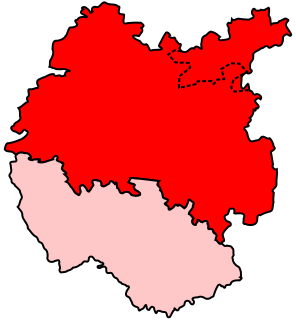
Leominster was a parliamentary constituency represented until 1707 in the House of Commons of England, then until 1801 in that of Great Britain, and finally until 2010, when it disappeared in boundary changes, in the Parliament of the United Kingdom.

Achavanich is an unusual megalithic horseshoe-shaped structure near Loch Stemster in Caithness, Scotland. Meaning "field of the stones", 36 of the original 54 remain today, mostly on the western side of the structure. The arrangement of these stones is extremely rare as the slabs are pointing towards the centre of the circle, rather than the typical side-by-side arrangement. The angle of the stones themselves is also strange. In most British stone circles, stones face the center with flat sides, but Achavanich's stones face the row at 90 degree angles. The stone circle remains open like a letter U, and evidence suggests it never was closed. The largest of the 36 remaining stones stands at only 2 meters, with an overall average of 1.5 meters tall. Although the site stood for several decades neglected and overgrown within a fenced off area which visitors were requested not to enter, access has recently been vastly improved with the clearance of the site, the repositioning of fence boundaries and the installation of information boards.

Aymestrey is a village and civil parish in north-western Herefordshire, England. The population of this civil parish, including the hamlet of Yatton, at the 2011 Census was 351.

North Herefordshire is a constituency represented in the House of Commons of the UK Parliament since its 2010 creation by Bill Wiggin, a Conservative.

The dolmens of Jersey are neolithic sites, including dolmens, in Jersey. They range over a wide period, from around 4800 BC to 2250 BC, these dates covering the periods roughly designated as Neolithic, or “new stone age”, to Chalcolithic, or “copper age”.
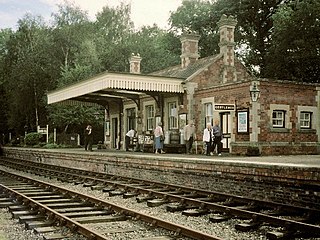
Rowden Mill railway station was a railway station located on the Worcester, Bromyard and Leominster Railway in England.

Leominster Museum, formerly known as Leominster Folk Museum, is an independent, volunteer-run, museum in Leominster, Herefordshire, England.

Humber is a hamlet and civil parish in the county of Herefordshire, England, and is 10 miles (16 km) north from the city and county town of Hereford. The closest large town is Leominster 3 miles (5 km) to the north-west.
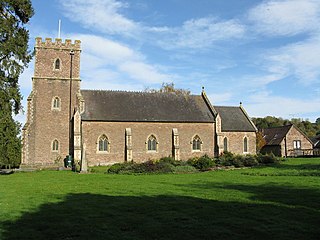
Ford and Stoke Prior is a civil parish in the county of Herefordshire, England, and is 10 miles (16 km) north from the city and county town of Hereford. The closest large town is the market town of Leominster, adjacent at the north-west. The parish includes the hamlet of Ford, the village of Stoke Prior, and the medieval parish churches of St Luke and St John of Jerusalem. At the west of the parish is the site of a Romano-British settlement.

Eye, Moreton and Ashton is a civil parish in the county of Herefordshire, England. The parish is 15 miles (24 km) north from the city and county town of Hereford. The closest large town is the market town of Leominster, 3 miles (5 km) to the south. Within the parish is the National Trust property of Berrington Hall.

Pudleston, is a small village and civil parish, in the county of Herefordshire, England, and is 13 miles (20 km) north from the city and county town of Hereford. The closest large town is Leominster 4 miles (6 km) to the west. At Pudleston is the c.1200 Church of St Peter, and the 1846 Tudor-Gothic Pudleston Court.

Staunton on Arrow is a village and civil parish in the county of Herefordshire, England. The village is 17 miles (27 km) north-west of Hereford and 8 miles (13 km) to the west of Leominster. Within the parish is the site of the Iron Age hill fort of Wapley Hill.
The Achavanich Beaker Burial refers to the remains of a prehistoric woman who lived around 4,000 years ago in the area of present day Achavanich, Caithness, Scotland. Ava, as she is now known, was discovered in 1987 by William and Graham Ganson and excavated by regional archaeologist Robert Gourlay, from the Highland Regional Council, and two assistant archaeologists: Gemma Corcoran and Sarah Hargreaves. Ava was found interred in a burial cist with a beaker, flints, a cow scapula, and possibly flowers.